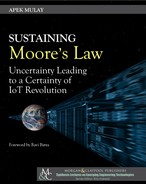12.8. CONCLUSION 89
12.8 CONCLUSION
As we conclude this chapter with an engagement with semiconductor industry thought leaders
about the future of the semiconductor industry based on their inputs in the volume Fabless: e
Transformation of the Semiconductor Industry, let me also take into consideration some other views
expressed by Chenming Hu, Robert Maire, Dan G. Hutcheson, Bijan Davari and Mark Bohr in
an article authored by Rick Merritt in EE Times entitled “Moore’s Law Hits Middle Age—Tales
from engineers who drove it forward.”
Chenming Hu, professor at Berkeley, California, as well as former chief technologist at
TSMC, said, “No exponential growth can go without an end.” He added, “We are getting to the point
where we are counting atoms, but I think Moore’s Law end will come earlier than that.” Hu said, “In
making things smaller in linear dimensions I believe we are not far from the end, so we will have to
look for other ways forward.”
I agree with Professor Hu about the necessity for new ideas to take Moore’s Law forward.
In Chapter 9 “Moore’s Law beyond 50,” I provided a free-market solution to continue this growth
in the number of transistors per square inch of an IC by ensuring a sustainable consumption of
electronics through the establishment of free-market economic policies.
Robert Maire, a semiconductor analyst, said, “To date, the progress Moore’s Law represents
has not been limited to just ever faster and cheaper computers but an infinite number of new applications
from communications and the Internet to smartphones and tablets. No other industry can claim similar
far-reaching impact on the lives of so many people [in] less than a lifespan, more changes in the world
can be traced back to the enabling power of the semiconductor industry than any other industry...More
lives have been saved and fortunes impacted.”
Robert Maire is precise in his analysis and hence it is very important for the semiconductor
industry professionals to look for new ideas to sustain a progress of Moore’s Law. Mass capitalism
presents some out-of-the-box ideas for the sustainable progress of Moore’s Law and also analyzes
the macroeconomic policies that have resulted in an earlier demise of this law.
Dan G. Hutcheson, CEO at VLSI Research, said, “e market value of the companies across
the spectrum of technology driven by Moore’s Law amounted to $13 trillion in 2014. Another way to
put it is that one-fifth of the asset value in the world’s economy would be wiped out if the integrated
circuit had not been invented and Moore’s Law never happened.”
Dan points out the important role played by Moore’s Law in the global economy. As long as
the progress of this important law can be sustained, the global economy will continue to prosper
from technological innovations, or else it will lose 20% of its share due to the demise of this law.
In this regard, proper macroeconomic policies have become critical for the progress of this law.
With a balanced free-market economic approach, there would not be any trade deficits or budget
deficits. Besides, increasing consumer demand will also increase the sales of electronics and thus
increase the market value of companies across the spectrum of technology driven by Moore’s Law.
Bijan Davari, an IBM fellow, said, “It won’t be like traditional Moore’s Law scaling in the
future, it will be more of a combination of things. Performance came from frequency enhancements
..................Content has been hidden....................
You can't read the all page of ebook, please click here login for view all page.
